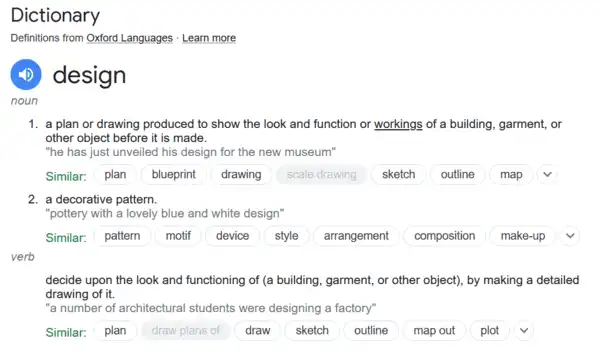 United Kingdom EN
United Kingdom EN United Kingdom EN
United Kingdom ENBy Stephanie Raaphorst
Senior Design Consultant , Amsterdam, The Netherlands
Digital
In the vast landscape that is design, there are many misconceptions about it. The origins of these misconceptions are simple misunderstandings arising from a difference of definitions. There are many varying meanings for the term ‘design’. If you look it up online, you’ll get two almost opposing definitions from the Google dictionary alone (see screenshot below):

There is good reason for this discrepancy as design has many different applications. It is a term that is used in many different industries. For example, in the mechanical automotive industry ‘the design’ may refer to the mechanical structure of the vehicle. In the urban planning industry ‘the design’ could refer to the layout of a city and the accessibility to public facilities.
The term ‘design’ is very flexible, which is entirely appropriate because it reflects its spirit: agility and adaptability. Depending on the context, this can be translated to actionable steps in many different ways. At Synechron we help to accelerate digital transformations for businesses within the financial services industry. Therefore, my definition of design could be appropriately framed as follows:
This is not to say that there aren’t other possible definitions that are appropriate in the design capability. Within the ‘Design at Synechron’ practice there are multiple different types of designers across the design practice. These include:
Each of these professions has its own, more specific adaptation of a design definition.
With so many possible definitions of design, it’s inevitable that confusion arises as to what exactly is. Now that we have established that design can have different definitions, let’s throw another term into the mix: Design Thinking.
Many people recognize this term as part of a hype in innovation or part of their company’s innovation policy. For those who aren’t entirely sure, or for those who have never heard this term, Design Thinking is defined as:
"Design thinking is a human-centered approach to innovation that draws from the designer's toolkit to integrate the needs of people, the possibilities of technology, and the requirements for business success."
Tim Brown, Executive Chair of Ideo
These four elements are what truly define Design Thinking and make for excellent innovation. However, a common misconception that often arises is: ‘Design Thinking simply requires having a designer on your team’. Much to my dismay, this is all too frequent.
Behind the Misconception
This misconception likely stems from the notion that designers ‘do their thing’ at the end of a project development process to make the developed solution even better than it was before. In reality, for a team to be most effectively implementing Design Thinking it is definitely useful to have a designer on board. Additionally, it is even more crucial to have a design-led process, regardless of the makeup of your team.
What this means is that designer or no designer, if your team follows the core guiding principles of Design Thinking (as mentioned above) in every step of the development process, you are utilizing Design Thinking to further innovate.
Take, for example, the implementation of a new internal document management system. The system has been identified and bought but still needs to be installed company-wide in a global enterprise. This typically involves:
1. Creating a project plan that outlines the steps needed to be taken to implement the new system, including the timeline, resources needed, and the roles and responsibilities of the team members involved.
2. Preparing the data from the old system. This involves identifying the documents that need to be transferred, categorizing them appropriately, and ensuring that the data is clean and accurate.
3. Configuring the new system. This involves setting up user accounts, configuring security settings, defining workflows, and integrating the new system with existing systems.
If we were to integrate the core guiding principles of Design Thinking (human-centered, needs of people, possibilities of technology, and requirements for business success) that implementation process might look something like this:
1. Creating a project plan that outlines the steps that need to be taken to implement the new system, including the timeline, resources needed, and the user’s needs.
2. Preparing the data from the old system. This involves identifying the requirements for success with the new system, identifying documents that need to be transferred, categorizing them appropriately, and ensuring that the data is clean and accurate.
3. Configuring the new system. This involves setting up user accounts, configuring security settings, defining user flows, and integrating the new system with existing technology and systems.
The two processes are almost identical -- except for the nuance of placing humans at the center of the solution (rather than technology or business requirements), and clearly defining what would make this a success for the business. Through just those small changes the team has already started to implement Design Thinking within their existing process.
Considering that the definition of Design Thinking still leaves much to the imagination as to the concrete steps to take, here is a quick how-to for the basic steps involved in Design Thinking (if it were to be viewed as a linear process):
As you can hopefully tell after this brief explanation, this is not something that one of your team members (a designer) can achieve on their own. It takes everyone’s input and effort to follow the Design Thinking process/principles. This is not to say that other methods fall away into the background. On the contrary. Design Thinking should be combined with existing development processes to become a new integrated norm, as opposed to a ‘one-off’ project approach adopted to fulfill the design specifications of a certain project. I believe that Design Thinking is best utilized when it is integrated as a framework into the company’s many other research, development and transformation processes.
To talk to Synechron about taking a valuable integrated design thinking approach, please reach out to the author at: Stephanie.Raaphorst@synechron.com